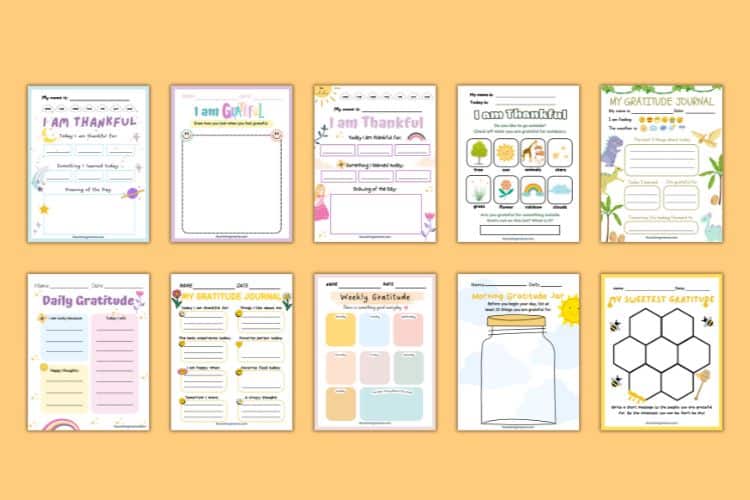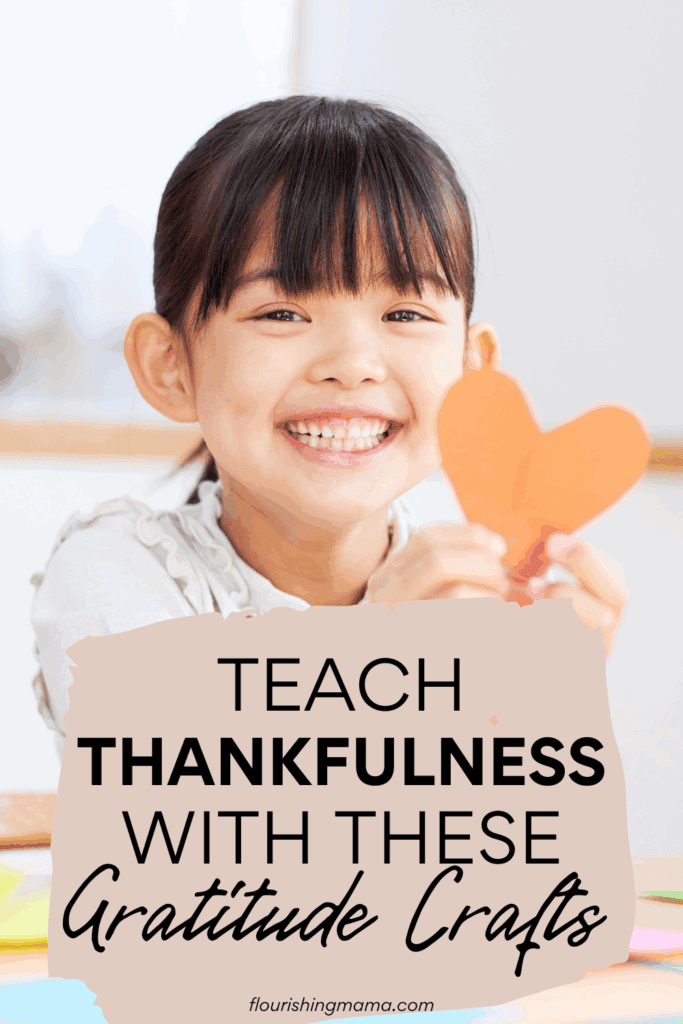31 Gratitude Activities for Kids to Encourage Thankfulness
In this post: Find 31 fun gratitude activities for kids to encourage them to develop thankfulness. Plus, download free gratitude prompts for the whole family to use.
Do you ever feel like you’re always preaching gratitude to your kids, but you aren’t sure how to actually demonstrate it? Gratitude is an essential value children need to learn at a young age, but how do you teach it?
My kids have grown up in a world of instant gratification. They don’t have to wait for much of anything. On-demand, instant, overnight, and rush are all parts of their basic vocabularies.

Having everything at their fingertips tends to breed discontent. (That’s true for adults, too.) But it’s our job as moms to help them learn gratitude as children. And we need to do more than just tell them how to practice gratitude.
That’s where gratitude activities come in.
As an Amazon affiliate, I earn from qualifying purchases.
Bonus: Keep reading to download your gratitude prompts.
35 Awesome Gratitude Activities for Kids
1. Write in a Gratitude Journal
Daily journaling is one of the most powerful ways to build a habit of thankfulness. Kids can draw or write about what they’re thankful for.

2. Read Books about Gratitude
Reading has so many great benefits–one of which is giving you and your child time to snuggle up and be together.
Use this family time as a time to read books about being thankful, and start a conversation about gratitude.
There are so many amazing books that will teach your child about being thankful. Here are a few favorites:
- The Grumbles: A Story About Gratitude
- Thankful
- I Am Thankful
- My Attitude of Gratitude
- Grunt the Grizzly Learns to be Grateful
There are so many amazing books that will teach your child about being thankful. Reading books brings so many great benefits, and your child will love the chance to snuggle up and read books with you!
3. Make a Gratitude Chain or Tree
Gratitude chains or trees are fun and easy crafts to help your child share what they are grateful for. Crafts are a great hands-on way to teach kids how to practice gratitude.
Make a chain or leaves from colorful paper. Each day of November (or whatever time your family is learning about gratitude) they can write something they’re grateful for.
You may want to make your chain stretch around the room, or cover a whole tree with paper leaves. The more you’re grateful for, the bigger your craft will become!
4. Create a Gratitude Collage
Give your child old magazines, scissors, glue, and a big piece of paper or cardboard. Ask them to cut out pictures of things they’re thankful for and glue them into a collage. They can also draw or write in the blank spaces.
5. Start a Dinner Table Gratitude Tradition
Make it a tradition to go around the dinner table each night and share one thing you were thankful for about today. It can be big or small, and mom and dad should also get in on the game.
Not only will this help kids find things to be grateful for, but it will also show them there is always something good about their day. Over time, you might find your family purposely looking for good things during the day.
Having a daily gratitude tradition will also keep your family close as you talk and share about your days while eating dinner.
6. Gratitude Competitions
There are so many fun ways to have gratitude competitions. You can see who can write down the most things they are grateful for in one minute, or see who can find the funniest thing to be grateful for.
Hang a whiteboard on the fridge, and encourage everyone to write something by dinner time. You can also see how many you can name throughout your day. Make these competitions fun and light, nothing too serious.
7. Make a Gratitude Bracelet
Use colorful beads and string to make bracelets, with each bead representing something your child is thankful for. As they wear the bracelet, they’ll have a visual reminder of their blessings.
8. Write Thank You Notes
In our digital age, writing thank-you notes is a lost art. But you can teach your child to write thank you notes from an early age. Plus, writing activities are a great way to improve reading and writing skills, that will help kids throughout their lives.
Younger children can paint or draw cards to help build creativity. As they get older they can copy simple messages which will improve handwriting. Eventually, they can write heartfelt, meaningful thank you notes on their own.
Writing thank you notes will teach gratitude and manners to your child as they learn they need to share their gratitude with others.
9. Thankfulness Hopscotch
Create a hopscotch board on your driveway or sidewalk using chalk. In each square, write something to be thankful for (like “family,” “food,” “home”). As your child jumps through, have them read and say something they’re grateful for in that category.
10. Rainbow Kind of Days
Bad days happen for all of us, but they’re sometimes harder for kids to deal with. They need to know that bad days happen, but we can turn them around.
Help them have a “rainbow kind of day.” Use this phrase when you have a bad day. Talk about the day, and struggles you went through. Then, tell your child about your rainbow–something good that happened.
Remind them that rainbows only come after the rain. Sometimes rain is nasty and even scary. But in the end, there often comes a beautiful rainbow.
11. Draw a “Thank You” Map
Ask your child to draw a “map” of their day (home, school, park, etc.) and add notes or drawings of things they’re grateful for at each location.

12. Have a Grateful Bedtime Routine
If you want to make gratitude a habit for your child, include it in your bedtime routine. Every night before bed, have them share what they were grateful for that day.
Make it a special time when the whole family gets involved. If you have family devotions or family prayer, encourage your kids to thank God for something.
They may say the same thing every night, or they may get creative and come up with different things. Either way, they’re learning to practice thankfulness every day.
13. Gratitude Puppet Show
Let your kids create sock puppets or paper bag puppets and put on a show where the characters talk about things they’re thankful for.
14. Create a Gratitude Jar
Find an empty jar and have your child decorate it. Make it pretty or fun–whatever it takes to encourage your family to use it. Keep some paper and a pencil nearby so it’s easy to use.
Then, write little notes of things you’re grateful for every day. Put the notes in the jar, and when it is full, empty it and read through everything you wrote!
This is a great practice to do during the month of November and read your notes on Thanksgiving Day.
15. Sticky Note Wall of Thanks
Keep a pad of sticky notes in the kitchen or near the door. Let your child write one thing they’re thankful for each day and stick it to a designated wall or door. Watch the wall fill up with colorful gratitude!
16. Thankful for Senses
Involving all the senses is always a great way to teach something! You can do this in so many different ways.
You can create a sensory bin filled with things your child loves and have them explore and be thankful for each item. This is especially great for younger kids.
Or you can ask your child something they love for each of their senses:
- Something they love to taste
- Something they love to touch
- Something they love to smell
- A sound they love to hear
- Something they love to see
Have them gather the items together to have a gratitude visual to share. This will also show you what their favorite items are you may not have known before!
17. Make a Gratitude Calendar
Print a blank calendar and encourage your child to write or draw one thing they’re thankful for each day. This is a great habit-building activity, especially during November.
18. Play Gratitude Bingo
Gratitude Bingo is not a daily activity but rather a week or month-long event that keeps thankfulness in the front of everyone’s minds. Give your child a bingo card with gratitude prompts inside each square.
You can make your own or get one online. Some square examples include:
- Tell someone why you are grateful for them
- Give a compliment to someone today
- Say please and thank you 10x today
- Write in your gratitude journal
When your child gets bingo, give them a prize. Make the blackout prize super special to help them learn how fun it is to be thankful for everything we have.
Participating in a long-term activity can help make gratitude a habit your whole family practices.
19. Make a Thankful Pumpkin
Instead of carving your pumpkin, write out all the things your entire family is grateful for. Try to fill the pumpkin with your writing!
To make it last longer, buy some faux pumpkins that you can make a part of your fall or Thanksgiving decor. You can give everyone their own small pumpkin, or keep the extras for next year.
Just keep adding to your collection. (If you happen to live in Florida, my friend Hanny has this great list of Orlando pumpkin patches you need to visit!)
20. Gratitude Story Time
Encourage your child to write or tell a short story where the main character learns to be thankful. You can even act it out or record it!

21. Go on a Gratitude Scavenger Hunt
Children love scavenger hunts! You can make this as easy or as hard as your child needs, depending on their age or abilities.
Here are a couple of ideas:
- Make hints about things you are grateful for to have them look for until they find the prize.
- Let them make their own scavenger hunt and give them prompts. For example, “something you’re grateful to wear” or “something you’re grateful to eat.”
- Download and print a scavenger hunt online, and talk about all the stuff you find.
If you’re looking for something fun to do after your big Thanksgiving dinner, a scavenger hunt is a fun tradition you can start this year.
22. Grateful Photo Challenge
Most kids really love to take pictures, so if they’re old enough, have them go on a photo challenge! They can use your phone or a kid’s camera.
You can choose to give them a list of things to take pictures of or let them find 20 things they are grateful for to take a picture of. You might even make a little photo book for them, or help them make a collage of their pictures.
23. Gratitude Guessing Game
Each person writes down one thing they’re thankful for and puts it in a bowl. Then take turns pulling out papers and guessing who wrote each one!
24. Gratitude Drawing or Painting
While it may seem so simple, children love a chance to draw or paint freely. Don’t lead this activity; let your child draw whatever comes to their mind.
Process art is much more beneficial than having your child copy a cute turkey you saw on Pinterest.
Let your kids’ creativity shine here. Instead of limiting them to crayons or markers, let them use something fun like paint or chalk. If your kids are a little older, you might even buy a cheap canvas for their artwork.
Be sure to hang up your child’s artwork and share how thankful you are for it!
25. Thankfulness ABCs
Go through the alphabet and try to name something you’re thankful for that starts with each letter. (A: apples, B: brothers, C: crayons…)
26. Go On a Gratitude Walk
Many children have a lot of energy that they love to use, so go on a gratitude walk! This can be a simple nature walk, but talk about things you see, hear, smell, and touch that you are grateful for during your walk.
It’s even better if you’re able to involve the whole family.
27. Photo Frame of Thanks
Let your child decorate a picture frame and insert a photo of someone or something they’re thankful for. Place it somewhere they’ll see every day.
28. Thankfulness Freeze Dance
Play music and pause it randomly. Each time it stops, everyone has to freeze and shout out something they’re thankful for before the music starts again.
29. Gratitude Telephone
Play a gratitude version of telephone. Whisper something you’re thankful for to your child, have them pass it on, and see how it changes (or stays the same) by the end.
30. Make a Thankful Wreath
Cut leaf shapes out of construction paper. On each leaf, write one thing your child is thankful for. Attach the leaves to a paper plate ring or cardboard circle to make a wreath and hang it on the door or wall.
31. Family Gratitude Challenge
Involve your whole family in a month-long gratitude challenge. Have a daily prompt where each family member shares something they’re grateful for in a certain category.
It might be a person, your favorite book, something about your church, or something good that happened. When everyone takes a part, kids can see you leading by example when it comes to being grateful for everything in life.
Helping Your Kids Practice Gratitude
Helping our kids develop a heart of gratitude doesn’t have to be complicated—it can be fun, creative, and part of everyday life.
Whether you’re making crafts, sharing thankful thoughts around the dinner table, or journaling together, these simple activities plant seeds that will grow into a lifelong attitude of thankfulness.
Try a few of these ideas this week and watch how your child’s perspective begins to shift. Gratitude is a gift—and one of the most powerful things we can teach our children.
Download the Gratitude Prompts
More Gratitude Activities
- 30 Inspiring Bible Verses about Thanksgiving and Gratitude (KJV)
- 10 Thanksgiving Bible Stories for Kids to Encourage Gratitude
- 30 Days to a Thankful Heart: Gratitude Challenge + Prompts for Moms
- Free Printable November Scripture Writing Plan
- Gratitude Journal for Moms
Pin for Later





One Comment